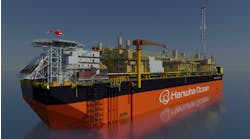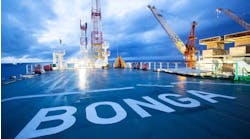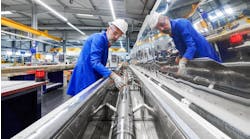Foamed cement becoming elegant deepwater solution
Rick Von FlaternTechnology Editor
- Compact nitrogen skid units make foamed cements a viable alternative offshore (photo courtesy Halliburton). [22,918 bytes]
- Flow meters indicate actual flow levels lagging behind pump stroke counters during pump rate changes (plot courtesy BJ Services). [5,344 bytes]
- A single printout provides operations supervisors with all data on all copmonents of a foamed cementing job (plot courtesy of Dowell). [12,44 bytes]
Of the many challenges that awaited deepwater explorers in the Gulf of Mexico, the most daunting may have been the aquifers that commonly flowed 1,000-3,000 ft below the ocean floor. Obtaining good casing cementations across these moving, unconsolidated sands was problematic only when possible.
Standard cements either washed away during the transition period, when gelling causes a loss of hydrostatic pressure, or were lost into a formation where fracture gradient and pore pressure are sometimes separated by less than one-half pound per gallon. The answer seemed to lay in foamed cements, where nitrogen-induced energy could sustain the cement's hydrostatic integrity through the critical transition time, and while its density could be kept sufficiently low to prevent fracturing. But foamed cements were unreliable, difficult to handle, and the complex equipment configurations ill-suited to offshore drilling rigs.
Foamed cement, which uses nitrogen injected into the slurry as it is being pumped downhole to reduce its density, has been used for nearly two decades to cement across depleted or low-pressure zones. But by the mid-1990s slurry instability, inconsistency, and high cost had all but eliminated the practice, even from the US West Texas fields where the such operations fell from about two a week to less than two per month.
Beyond those difficulties, use of foamed cements offshore was made even less attractive by space considerations. "You have a cementing skid off in a room someplace and put your nitrogen skid up on the deck and there was really poor communications," said Halliburton technical analyst, Ronnie Fall of early offshore foamed cement jobs.
Still, as shallow water flows continued to plague deepwater efforts, it became increasingly obvious the industry's best response was nitrogen-foamed cement. Its compressibility allows it to stem water influx even through the transition stage and it is less susceptible to fluid loss. Too, its unique rheology lends itself well to hole cleaning and cuttings removal. "Deepstar looked at all available slurries and what happened with influx," Fall said. "Head and shoulders above was the foamed cement systems for giving a bond around the pipe."
Since most foamed cement work being done offshore involves setting conductor pipe, bond logs are not run. However, evidence from more than 100 successful such operations would seem sufficient to bear out the industry consortium's conclusions.
Reconciling the offshore environment's demands for space economies and precise communications required techno logical innovation - a concept nearly anathema to the staid traditions of the cementing world. While automation, direct metering, and computerization had been making inroads into fracturing, cementers had somehow resisted such changes. But in the last two years, the demands of deepwater have forced changes and swept cementing operations in the 1990s.
Monitoring slurries
Even on land, where operators of the various nitrogen, pumping, and additive units that must run simultaneously on a foamed cement job can clearly see and hear each other, inconsistencies are inevitable. By the time an operator recognizes a problem with his own unit, the situation usually has existed for some period of time. Even then, after the problem is discovered, time passes before the failure can be corrected or the other units alerted and their rates altered to accommodate the failing piece.As a result, it is not unusual for a cement pump to lose prime and cause a sizable quantity of nearly pure nitrogen to be pumped before corrections are made. Inversely, when a nitrogen pump fails, an overly dense, often sizable, slurry is sent downhole.
In the past, foamed cement operations have normally resulted in something between those two extremes with a slurry either heavier or lighter than planned. While the discrepancy often falls within an acceptable margin of error on land-based wells, in critical, high-risk deepwater cementing jobs such mistakes can be catastrophic.
The answer being pioneered by the industries largest cementing contractors - Dowell, Halliburton, and BJ Services - is computerization and centralization. Through computerized monitoring and interconnected unit controls, cementers now claim they can assure operators precise, predictable cement jobs, even from the cramped decks of deepwater drilling rigs.
"With the metering and monitoring systems we have now, the computer takes care of that (density consistency)," said Murray Rogers, BJ Services' cementing coordinator. "We have better control to stabilize these foams."
BJ uses two meters to attack the problem of reliable densities - a magflow meter on cement slurry and a mass flow meter on the nitrogen meter to directly measure nitrogen flow. "We hooked a meter on the cement slurry, so now instead of rationing nitrogen and our foaming agent to a triplex pump stroke count, we are actually measuring slurry range," said BJ mechanical engineer, Bob Judge. "Pump rate measure is an indirect measurement. It is a measure of how fast your pump is turning, not necessarily how fast you are pumping slurry."
Judge uses a job record, a plot of bbl/minute vs. total slurry, to prove his point. The chart was drawn with both pump stroke counts and with a flow meter. After pumping about 100 bbls, stroke counting indicated completion of a rate increase of about 4.5-5.0 bbl/min. A flowmeter, on the other hand, indicated about 25 bbls were pumped before the higher rate was actually achieved. "What is happening is we are not getting 5.0 bbl/min, but 4.5 bbl/min," Judge said. "If we were rationing nitrogen at 5.0 bbl/min we would have been wrong. There is a pretty good stretch of time when it (pump rate) is not accurate."
That is not to say pump stroke counting is not viable, just not the first best choice. "We aren't proposing to do away with pump stroke counting because we use it for backup," said Rogers. "If one of those flow meters go down we are going to look at pump strokes because they are there. It is set up so if you throw a switch you are looking at pump strokes."
Working in concert
Accurately knowing the rates of the individual components being injected into the slurry is one thing. The key to consistent densities is to act upon them in unison. To do that, cement contractors have electronically tied their pumping units to all other pieces of the operation, and by doing so have converted the familiar oilfield iron into something of a control central."Everything is slaved to the cementing unit," said Dowell's Dave Stiles. "A mass flow meter is used for slurry rate, which controls a servo mechanism at the nitrogen unit, which passes through an absolute flow meter to verify that the amount supposedly being injected is indeed being injected."
CMS (continuous metering system) is the Halliburton acronym for its electronic additive system which automatically injects foaming surfactants and stabilizers at the triplex pump station and ascertains that the proper, pre-nitrogen-injection slurry density is maintained. That mixture is then sent to a foam generator and an automatic nitrogen injection unit.
As with Dowell and BJ, all the parts are tied to the action of the cementing unit. "They are all tied together," Fall said. "They are all daisy-chained so that the pump rate on the cement unit controls both the injection of the CMS skid and the pump rate of the nitrogen."
"The nice thing about automating the system is that when things go wrong the system reacts automatically," Judge said. In reality, automation is only in place to a point.
While everything is monitored by computer, once the problem is displayed to a job supervisor, a hand on the pump throttle is still required to change the pump speed. Auto mation, in this instance, means that one handle controls all the other units which greatly reduces, if not eliminates, time lags between detection and action. The upshot, say all the contractors, is that their systems react in a matter of seconds.
But density consistency is not a simple matter of maintaining a simple designated pound per gallon figure throughout a job. Like most casing cementations, the job is carried out in stages calculated to spot specific density slurries at specific depths. Naturally when a stage change is made and the density or composition of the slurry is altered, it is done without stopping the job.
To maintain density integrity during these stage changes, every part of the operation must act in unison. And within the latest automated systems that is a relatively simple and pre-programmable matter. In fact, BJ engineers claim that though they hardly expect to be challenged to do so, they are able to program as many as 50 density changes into any single operation.
More critical than automating staging, however, is what some call constant densities. Nitrogen foamed cements have a tendency to alter densities from top to bottom. An average 12 ppg slurry is more often, in reality, about 11.8 ppg at the top of the casing and 12.2 ppg at the shoe. Automation and computer control of nitrogen rationing per unit of cement allows operators to so finely ramp slurry densities that they can create essentially uniform slurry density throughout the length of the casing.
Timing is right
Foamed cements, once the rising star for use in underpressured zones, were all but abandoned in recent years as too unreliable and too expensive. But as has happened so often in the recent industry movement into deepwater, and earlier during times of minimal profit margins, need has forced technological creativity. Ironically, it is overpressured zones that have resurrected the technique.And expense is a relative thing. "The price tag and reliability (issues) killed it," Rogers said. "The price tag is still there, but it is less expensive than other conventional low-densities such as glass beads and doesn't have the pressure limitations these things have."
And the need that brought foamed cements back into favor shows no sign of relenting. Dowell, which performed its first foamed cement job on Easter Sunday of 1996, has done nearly 40 successful shallow aquifer cement jobs since. Halliburton has been called on to do 75 such jobs, 65 of them in 1997. BJ Services has been perfecting their systems offshore Qatar where, until their arrival on the scene, flaring gas from shallow flows was routine. They are now bringing what they've learned to the US Gulf and other offshore theaters.
In short, the presence of over-pressured shallow aquifers is apparently destined to be a fact of life for as long as drillers work in deep and ultradeep waters. "The places they thought they would see it - they have seen it," said Fall. "And in one case, an operator had drilled 14 wells in a block and not seen it, and another operator saw it in the very next block and lost their first well."
The Genesis Field required 38 foamed cement jobs. And Shell's Ursa, in nearly 4,000 ft of water, reportedly had the highest flowrate yet recorded from any of the over-pressured shallow sands.
Proof that foamed cement jobs are working is strong, even though evidence is anecdotal since bond logs are not run on the large conductor casings involved in the majority of the work. In all its work, for instance, Halliburton reports just one post-cementing flow.
Computerization has provided the communication and control necessary to simultaneously operate equipment that must be scattered throughout a rig in order to fit its close quarters. It is difficult to imagine another answer to the problem of shallow water flows in deepwater fields.
"Certainly the process control ends up making the whole operation much simpler," said Stiles. "It really goes off just like a normal cement job once you get up and running. I think the quality we deliver downhole is incrementally better."
Copyright 1997 Oil & Gas Journal. All Rights Reserved.


